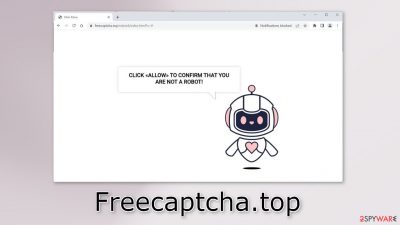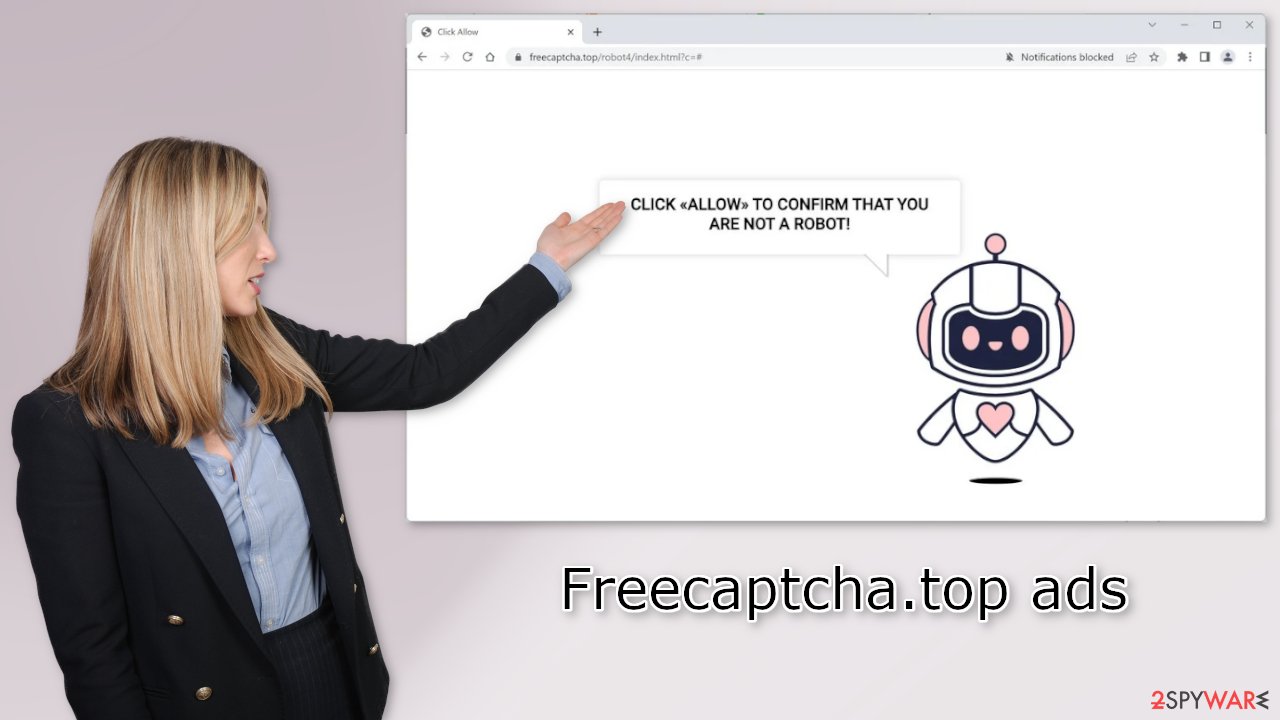Freecaptcha.top ads (fake) - Free Instructions
Freecaptcha.top ads Removal Guide
What is Freecaptcha.top ads?
Freecaptcha.top is a money generator for crooks who know how to use social engineering

Freecaptcha.top may seem like a captcha verification step but in reality, it is a bogus website created by crooks to monetize user activity. It asks people to press the “Allow” button to confirm that they are robots but actually people subscribe to push notifications. The page uses social engineering tactics to fool users.
They start getting spammed with annoying pop-up ads that can appear even when the browser is closed. Unfortunately, they might be displayed by rogue advertising networks that place ads leading to dangerous websites. People can end up on scam pages that promote fake antivirus programs, software deals, giveaways, and surveys.
This can lead to personal information disclosure to cybercriminals, PUP (potentially unwanted program),[1] and malware installations. Although push notification spam is not considered to be a virus, it can lead to serious problems if users are not cautious.
| NAME | Freecaptcha.top |
| TYPE | Push notification spam; adware |
| SYMPTOMS | Pop-up ads start appearing in the corner of the screen |
| DISTRIBUTION | Shady websites, deceptive ads, freeware installations |
| DANGERS | The ads can contain links leading to dangerous websites where users could get tricked into providing their personal information or downloading PUPs and malware |
| ELIMINATION | Go to your browser settings to disable notifications |
| FURTHER STEPS | Use a maintenance tool FortectIntego to get rid of any remaining damage and clear your browsers |
Distribution methods
People rarely find pages like Freecaptcha.top in the search results. Usually, they hide in other shady sites that are unregulated. For example, illegal streaming platforms[2] are full of deceptive ads and sneaky redirects that can take people to dangerous pages.
You should avoid clicking on random links and buttons. Only visit sites that you know are safe. Use legitimate streaming services instead of illegal streaming platforms because they are breeding grounds for all kinds of malware. Beware of fake “Download” and “Play” buttons[3] on torrent sites and peer-to-peer file-sharing platforms.

Software bundling
Sometimes, push notification spam pages can appear without any user input. This can happen if you have an adware[4] infection. Adware is advertising-supported software that generates revenue from pay-per-click advertising. It can display pop-ups, banners, and cause redirects.
Most of the time, users infect themselves with adware when using freeware distribution platforms. They include additional programs in the installers to make a profit. The bundled software is not always safe and can cause quite a lot of problems. You should always be careful during the installation process or use only official web stores and developer websites whenever you want to download software.
We recommend choosing the “Custom” or “Advanced” installation methods and reading the Privacy Policy and Terms of Use. The most important part is to check the file list and untick the boxes next to any unrelated apps in the list to prevent them from installing.
Remove browser pop-ups
To get rid of intrusive pop-up ads, you have to go to your browser settings and block the permission manually. The process is quite simple, as we show below:
Google Chrome (desktop):
- Open Google Chrome browser and go to Menu > Settings.
- Scroll down and click on Advanced.
- Locate the Privacy and security section and pick Site Settings > Notifications.
![Stop notifications on Chrome PC 1 Stop notifications on Chrome PC 1]()
- Look at the Allow section and look for a suspicious URL.
- Click the three vertical dots next to it and pick Block. This should remove unwanted notifications from Google Chrome.
![Stop notifications on Chrome PC 2 Stop notifications on Chrome PC 2]()
Google Chrome (Android):
- Open Google Chrome and tap on Settings (three vertical dots).
- Select Notifications.
- Scroll down to Sites section.
- Locate the unwanted URL and toggle the button to the left (Off setting).
![Stop notifications on Chrome Android Stop notifications on Chrome Android]()
Mozilla Firefox:
- Open Mozilla Firefox and go to Menu > Options.
- Click on Privacy & Security section.
- Under Permissions, you should be able to see Notifications. Click Settings button next to it.
![Stop notifications on Mozilla Firefox 1 Stop notifications on Mozilla Firefox 1]()
- In the Settings – Notification Permissions window, click on the drop-down menu by the URL in question.
- Select Block and then click on Save Changes. This should remove unwanted notifications from Mozilla Firefox.
![Stop notifications on Mozilla Firefox 2 Stop notifications on Mozilla Firefox 2]()
Safari:
- Click on Safari > Preferences…
- Go to Websites tab and, under General, select Notifications.
- Select the web address in question, click the drop-down menu and select Deny.
![Stop notifications on Safari Stop notifications on Safari]()
MS Edge:
- Open Microsoft Edge, and click the Settings and more button (three horizontal dots) at the top-right of the window.
- Select Settings and then go to Advanced.
- Under Website permissions, pick Manage permissions and select the URL in question.
![Stop notifications on Edge 1 Stop notifications on Edge 1]()
- Toggle the switch to the left to turn notifications off on Microsoft Edge.
![Stop notifications on Edge 2 Stop notifications on Edge 2]()
MS Edge (Chromium):
- Open Microsoft Edge, and go to Settings.
- Select Site permissions.
- Go to Notifications on the right.
- Under Allow, you will find the unwanted entry.
- Click on More actions and select Block.
![Stop notifications on Edge Chromium Stop notifications on Edge Chromium]()
Get rid of cookies and cache
It would be best to avoid shady pages that engage in illegal activities. They can use cookies to track your IP address and geolocation. Websites also have the ability to collect data about your browsing behavior like the websites you visit, searches you make, what you purchase online, etc.
Cookies and cache are small data files stored in your system so they can slow down your device. After you stop the ads from coming, we recommend taking care of your browsers by clearing them. You can do it automatically with FortectIntego. This will delete the information websites have collected about you and will improve system performance.
Scan your system with anti-malware tools
If the previous removal method did not work, this will most likely fix it. You have to eliminate the app that is causing the erratic behavior in the background from your system. Using SpyHunter 5Combo Cleaner or Malwarebytes professional security tools would make the process much easier for you as they can automatically remove intruders by scanning your system. Doing it manually does not work for everyone, as it is unclear which application is at fault.
However, if you still want to do this yourself, here are the step-by-step instructions:
Windows 10/8:
- Enter Control Panel into Windows search box and hit Enter or click on the search result.
- Under Programs, select Uninstall a program.
![Uninstall from Windows 1 Uninstall from Windows 1]()
- From the list, find the entry of the suspicious program.
- Right-click on the application and select Uninstall.
- If User Account Control shows up, click Yes.
- Wait till uninstallation process is complete and click OK.
![Uninstall from Windows 2 Uninstall from Windows 2]()
Windows 7/XP:
- Click on Windows Start > Control Panel located on the right pane (if you are Windows XP user, click on Add/Remove Programs).
- In Control Panel, select Programs > Uninstall a program.
![Uninstall from Windows 7/XP Uninstall from Windows 7/XP]()
- Pick the unwanted application by clicking on it once.
- At the top, click Uninstall/Change.
- In the confirmation prompt, pick Yes.
- Click OK once the removal process is finished.
macOS:
- From the menu bar, select Go > Applications.
- In the Applications folder, look for all related entries.
- Click on the app and drag it to Trash (or right-click and pick Move to Trash)
![Uninstall from Mac 1 Uninstall from Mac 1]()
To fully remove an unwanted app, you need to access Application Support, LaunchAgents, and LaunchDaemons folders and delete relevant files:
- Select Go > Go to Folder.
- Enter /Library/Application Support and click Go or press Enter.
- In the Application Support folder, look for any dubious entries and then delete them.
- Now enter /Library/LaunchAgents and /Library/LaunchDaemons folders the same way and terminate all the related .plist files.
![Uninstall from Mac 2 Uninstall from Mac 2]()
How to prevent from getting adware
Do not let government spy on you
The government has many issues in regards to tracking users' data and spying on citizens, so you should take this into consideration and learn more about shady information gathering practices. Avoid any unwanted government tracking or spying by going totally anonymous on the internet.
You can choose a different location when you go online and access any material you want without particular content restrictions. You can easily enjoy internet connection without any risks of being hacked by using Private Internet Access VPN.
Control the information that can be accessed by government any other unwanted party and surf online without being spied on. Even if you are not involved in illegal activities or trust your selection of services, platforms, be suspicious for your own security and take precautionary measures by using the VPN service.
Backup files for the later use, in case of the malware attack
Computer users can suffer from data losses due to cyber infections or their own faulty doings. Ransomware can encrypt and hold files hostage, while unforeseen power cuts might cause a loss of important documents. If you have proper up-to-date backups, you can easily recover after such an incident and get back to work. It is also equally important to update backups on a regular basis so that the newest information remains intact – you can set this process to be performed automatically.
When you have the previous version of every important document or project you can avoid frustration and breakdowns. It comes in handy when malware strikes out of nowhere. Use Data Recovery Pro for the data restoration process.
- ^ Chris Hoffman. PUPs Explained: What is a “Potentially Unwanted Program”?. Howtogeek. Technology Magazine.
- ^ Nina Khalouf. Illegal streaming websites spike in popularity. EagleEye. News.
- ^ Andy Maxwell. Google Targets Fake ‘Download’ and ‘Play’ Buttons. Torrentfreak. Filesharing News.
- ^ Adware. Malwarebytes. Cybersecurity Basics.














